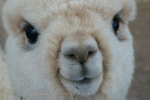Articles by Alpaca World Magazine:
The plight of the Peruvian alpaca farmer
Kristen Peterson
The plight of the Peruvian alpaca farmer; a veterinarian's experience in Peru
Kristen Peterson, DVM, is a veterinarian in rural Minnesota who works mostly with small animals, there are lots of dog mushers in the area, and with the North America Bear Center. While in vet school Kristen spent her summers working with musk ox, bison, bears and other wild animals at the Alaska Wildlife Conservation Center. Last December she headed for Peru to volunteer for the USA based Nunoa Project.
Alpacas don?t spit at you when they're angry, they regurgitate at you. I am standing in the middle of a corral in the Andes Mountains in Peru and attempting to age a female alpaca by looking at her teeth. The male handler who is ?assisting? me fails to hold the animal?s head off to the side, and she continues hurling her sour stomach contents into my face and hair. I shoot a look up at the man; he is laughing.
Agh, I think. Why is this man laughing? Doesn?t he care that I am spending my vacation under the sweltering sun, with alpaca spit in my hair? More importantly, doesn?t he care about improving his community?s alpaca herd, raising more animals, with higher quality fibre and thus earning more money for his family?
In reflection, yes, I?m sure the man cared. The Andean alpaca farmer has too many cares, the likes of which my mind is rarely troubled: where to find water, how to reach healthcare, and how to shelter a family from the harsh environment of the Andean plateau, among many others. In the end, for my ?assistant,? it was just another day of work. Who doesn?t like to have a little fun at work?
I spent two weeks of December working with alpaca farmers in the altiplano region of Peru, as part of the Nuņoa Project, an organization which uses herd management strategies to augment the income of the alpaca herder and improve their quality of life.
Dr. Stephen Purdy is the president and founder of the Nuņoa Project. I met Dr. Purdy during my final year of veterinary school and stayed in contact, hoping one day to participate in the Nuņoa work. Dr. Purdy says when students tell him they?d like to accompany him to Peru, his response is, ?Sure, but be prepared to be sick for 10 days.? Sounds about right.
The altiplano, or high plains, lies within the central Andes, mostly in Peru and Bolivia. The elevation averages over
12,000 feet, although most of our work was done between 14,000 and 15,000. The altiplano was once the political and cultural center of the Inca empire, home to the capital city of Cuzco.
Alpaca herds dot this area, along with the occasional llama. Alpaca fibre that was once produced to clothe the Inca royalty is now sold to western tourists in high-end clothing stores or lower quality street stands. The alpaca farmer relies on the sale of this fibre to feed his family. High herd birth rates and healthy animals mean more money and higher living standards for the farmer.
Veterinary intervention on this scale is termed ?production animal medicine,? and places the highest value on the health of a herd, not necessarily the individual animal. Anyone familiar with livestock farming in North America knows that economic success is contingent upon good management strategies. A farmer must know his animals and know if they are making him money. Although this may sound harsh to non-farmers, often the means of achieving
this is by taking good care of your animals. Feed your animals well and keep them comfy, and they are more likely to thrive, resulting in more fibre for sale. Of course, this is oversimplifying the job.
Tweet



